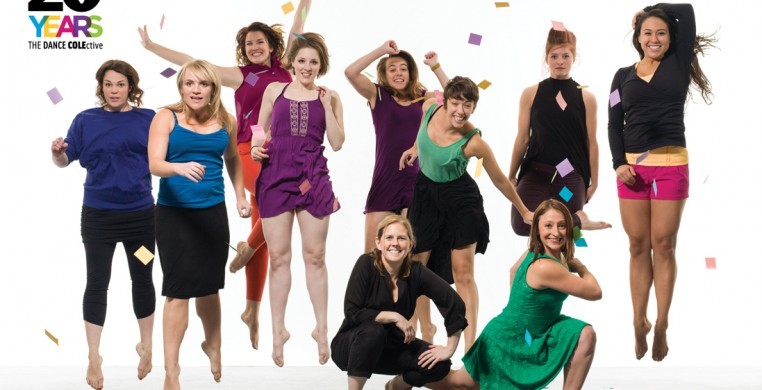A breezy naturalism wafted across the largely pastel palette of dances in The Dance COLEctive’s “Revelry/20 Years,” playing at Links Hall through March 20th in celebration of the company’s twentieth anniversary. A hallmark of almost all the pieces is the easy-going sensuality of women navigating the balance and weight of each other’s bodies, women dancing about being women, sisters, lovers, friends, community; women lifting each other, supporting each other, existing in and out of each other’s isolation, and coming together in the gentle harmony of touch. Easy to watch; you might even call this collection of ladies of many shapes and sizes comforting, or comfortable, which speaks to the program’s strengths as well as its limitations.
There was an innate comfort level to Margi Cole’s exploration of the self within limited confines in “threadwork,” Margaret Jenkins contemplative solo for COLEctive’s artistic director. An economy of gesture, performed with both ease and the deliberate clarity of shape, made every movement count as the dancer transforms herself in each of several spaces, geometrically-defined by ropes along the floor. We find her first inside a circle, her head and elbows responding in quizzical circumspection to the pizzicato strings of David Keating’s music. Next, the dancer creates and then travels down a long diagonal corridor, as if drawing her own route, her arms and legs mirroring the parallel lines of the ropes. Finally, she reaches a square in a vigorous sequence of liberating jumps and the breathy abandon of arms circumscribing her head, alternately hugging herself and culminating in a triumphant relevé, arms reaching to the ceiling, head focused upward. Each shape seems to represent a new phase of existence, new awareness, and the empowerment to move through these confines of self, obliterating the shapes by gathering up the ropes and moving on. In a climactic close, Cole approaches the audience, turns her back, then turns her head to look one more time--into the future perhaps, or is it eternity--and audibly gasps, then retreats toward the back of the stage, stops, and gasps once more before the lights fade to black.
The melding of non-verbal movement with vocalization can be stunningly dramatic, but, as with movement, even with abstract dance, it must come from the wellspring of dramatic intention, fully-realized in both mind and body. This performance didn’t quite reach that unity of purpose, and what was otherwise a quite lovely and honestly-portrayed tone-poem in movement was marred by a false note. The audience doesn’t need to know exactly what makes the performer gasp, but the image must be crystal clear to the performer for the vocal gesture to have meaning beyond just another step in the dance.
Former TDC dancer Kate Petrunich’s “The Second Line” takes eight women in period dresses and summer togs to the seashore. Sound effects of aquatic birds, waves, and wind create an outdoor landscape where the women carry each other and sway and fall back into each other's arms, grouping and regrouping in energetic spatial patterns. Here too, audible vocalizations of laughter and crying come out of nowhere and add puzzling context to what is otherwise a feel-good mood. Suddenly we wonder who are these women and what do they want. The piece, with all of its pleasant sensuality, only hints at a choreographic concept we have missed.
Shannon Edwards’ “There There” is a prime example of more of the same, with a quartet of women in drab early twentieth-century house dresses awakening in the same household to country and western music by Hank Williams and Nolan Wicklund. They comfort each other, and the audience, in a meandering but pleasant narrative of a day in the life. There are a lamp, an old table, a lace doily, and the rituals of daily life--washing, dressing, setting a table, eating a communal meal, going to bed. And being lonely, so the songs say. Aside from some easy-going lifts that launch into an unexpected leap, the movement vocabulary doesn’t distinguish itself beyond the breathy naturalism and female intimacy of the previous pieces.
Expansive movement phrases, breath-driven and naturalistic, with deliberate camouflaging of technical dance characterize a particularly prevalent stylistic conceit of Columbia College’s dance department, where Cole, Petrunich, Edwards, and most of COLEctive’s present and former company members trained. This style, while easy on the eye, creates a sameness of palette. At its best in Cole’s two superbly-crafted and beautifully performed duets, “Kindred Thing,” and “Secret Self” (2003), it reveals the nuances of relationship through the intimacy of balance, weight, and breath. In the less-skilled hands of younger choreographers, its repetitiveness begs more movement innovation.  Margi Cole
Margi Cole
The one exception was Cole's “The Swell,” with Jeff Hancock’s stunningly bold costume variations on a theme of red and black, and with Cole’s jazz-tinged explosiveness in this premiere for five dancers, a departure from the breathy flow of dips and curves in her two preceding pieces. In an almost combative movement dynamic, dancers jabbed and jutted their way across Juan Alarçon’s soundscape of cheers, crowd noise, and electronic music. Sexy agressiveness tinged with urban angst propelled the momentum of duets, trios, and full-group dancing toward a climactic culmination, wild and disturbed until, staggering, they ultimately coalesce in a powerful diagonal formation in unison--submission or solidarity, anyone’s guess.

